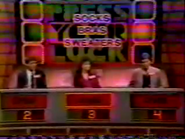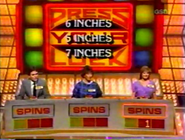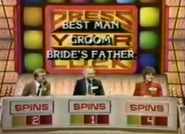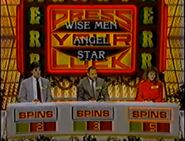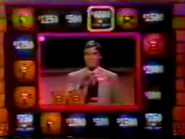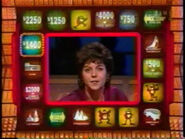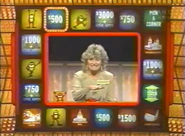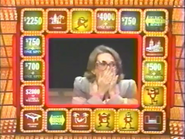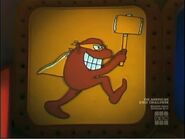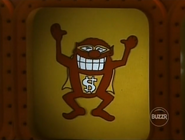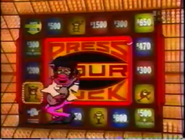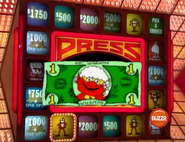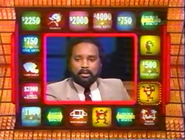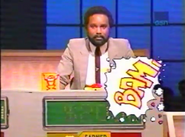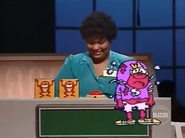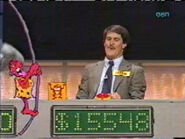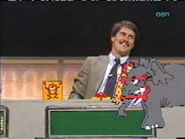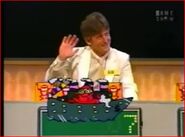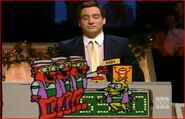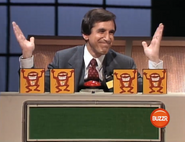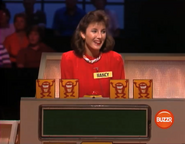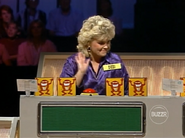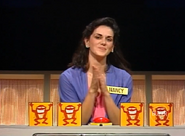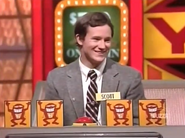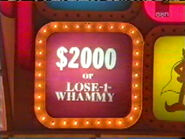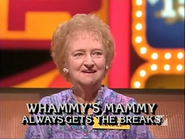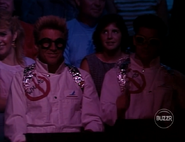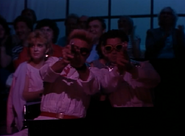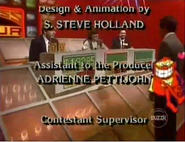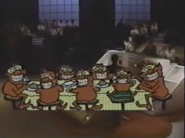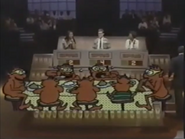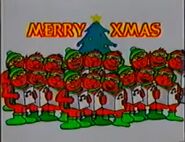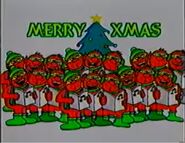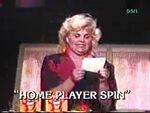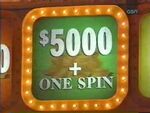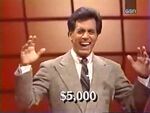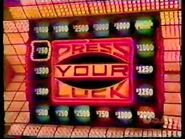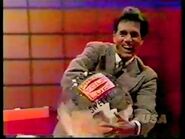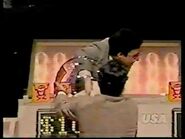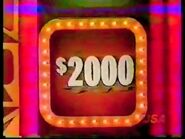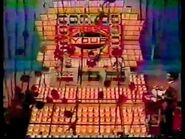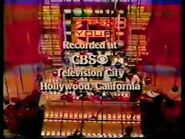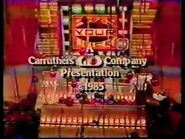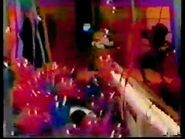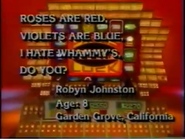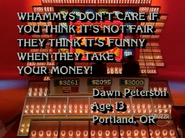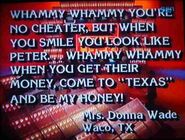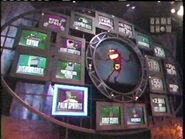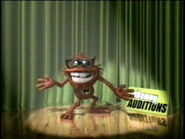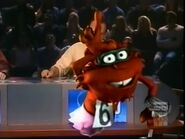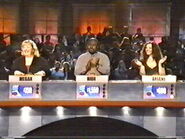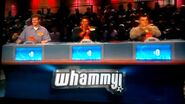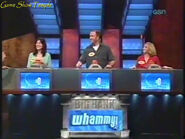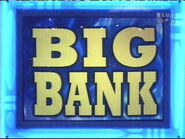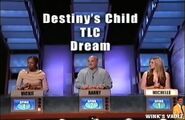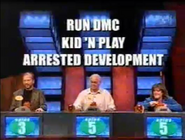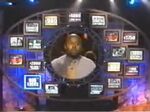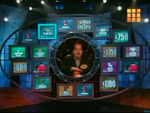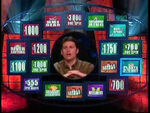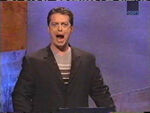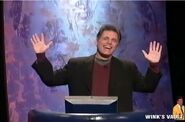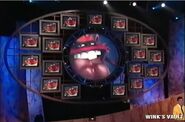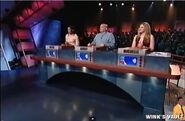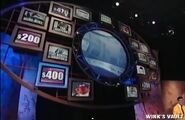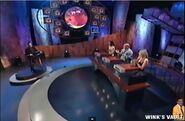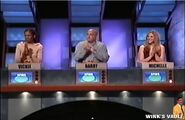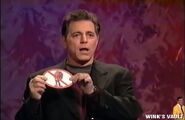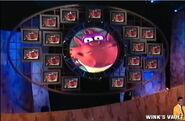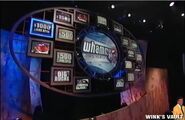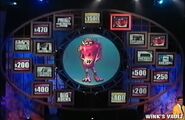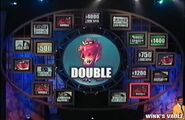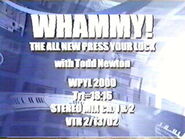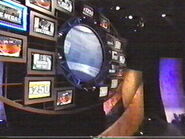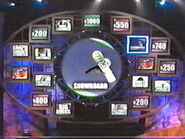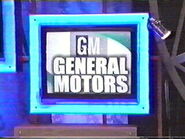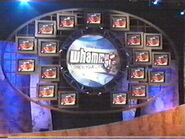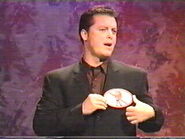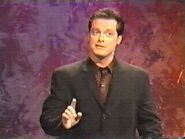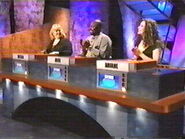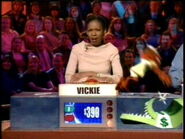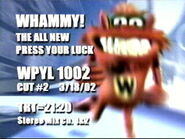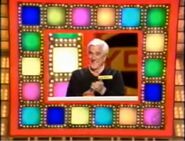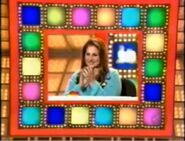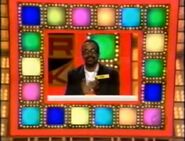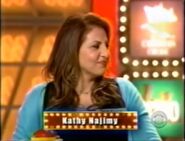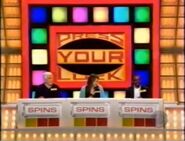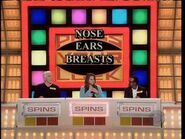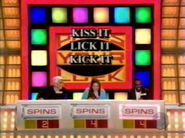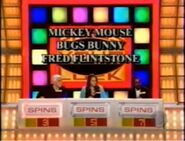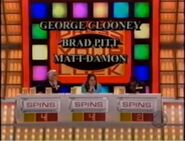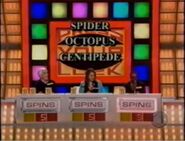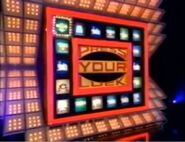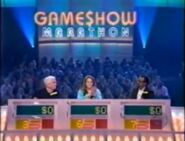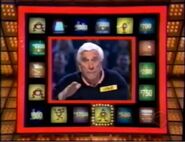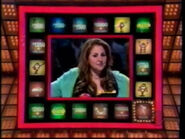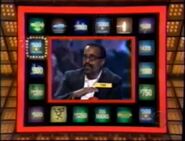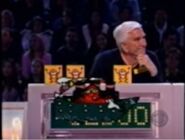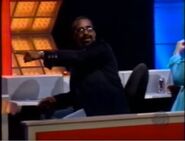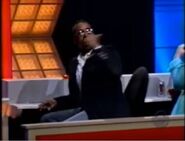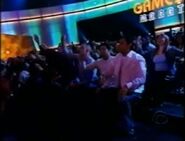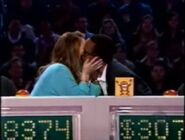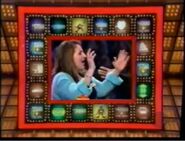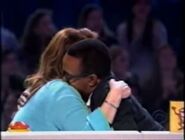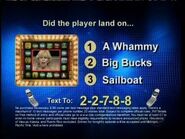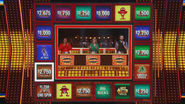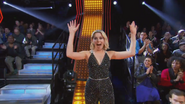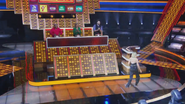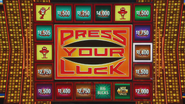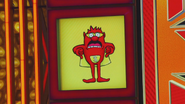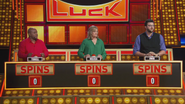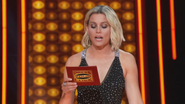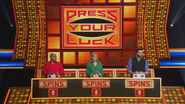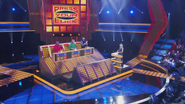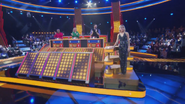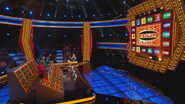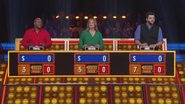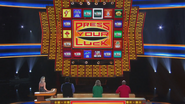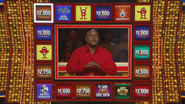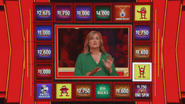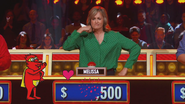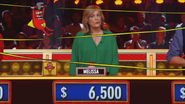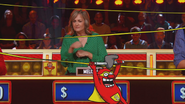(→Music) Tag: Visual edit |
|||
| Line 435: | Line 435: | ||
1983 – Robert Israel & Lee Ringuette<br /> |
1983 – Robert Israel & Lee Ringuette<br /> |
||
2002 – Alan Ett & Scott Liggett<br /> |
2002 – Alan Ett & Scott Liggett<br /> |
||
| − | 2006 – Score Productions |
+ | 2006 – Score Productions<br> |
| + | 2019 - Tim Mosher & Stoker |
||
<gallery position="center"> |
<gallery position="center"> |
||
Revision as of 03:05, 2 July 2019
| Hosts | |
| Peter Tomarken (1983–1986, 2002 Pilot #1) Todd Newton (2002 Pilot #2, 2002–2003) Graham Elwood (4/1/2003) Ricki Lake (Gameshow Marathon, 2006) Elizabeth Banks (2019–Present) | |
| Announcers | |
| Rod Roddy (1983–1986) Gary Kroeger (2002–2003) Rich Fields (Gameshow Marathon, 2006) Neil Ross (2019–Present) | |
| Sub-Announcers | |
| John Harlan (1984) Charlie O'Donnell (1986) | |
| Broadcast | |
| CBS Pilot: 5/18/1983CBS Daytime: 9/19/1983 – 9/26/1986Pilots: 2/13/2002Game Show Network (Daily, Whammy!): 4/15/2002 – 12/5/2003CBS Primetime (Gameshow Marathon): 6/8/2006ABC Primetime: 6/12/2019 – Present | |
| Packagers | |
| Carruthers Company Productions (1983–1986) Fremantle (2002–Present) Granada (2006) Brownstone Productions (2019–Present) | |
| Rerun Distributor (1987) | |
| Republic Pictures Television | |
Press Your Luck (and its reboot Whammy!: The All-New Press Your Luck which was later shortened to Whammy! in 2003) is one of the most popular cult-classic game shows of the 1980s of all time. People answered questions to earn spins on the Big Board for a chance to win "Big Bucks"! However, there were evil Whammies lurking about. Each time one was hit, they would take away all of the contestant's accumulated winnings up to that point. The show itself was a remake of the short-lived 1977 ABC Daytime game show called Second Chance.
Gameplay (Press Your Luck)
The original Press Your Luck ran on CBS for three years from September 19, 1983 until September 26, 1986, hosted by Peter Tomarken and announced by Rod Roddy. The gameplay was similar to Second Chance but with a few slight alterations.
Question Round
In the question rounds, Peter asked four questions one at a time. On each question the first player to buzz in had a chance to answer. The answer he/she gave became the first of three answers for his/her two opponents to choose from. A correct buzz-in answer was worth three spins while a correct multiple choice answer was worth one spin. In the event a contestant who buzzed in first ran out of time, that contestant had to sit out the rest of the question while the other two players played the multiple choice part of the question. In the event that no contestant buzzed in when time ran out, all three contestants played the multiple choice part of the question. 20 spins were available in each question round, but the highest one contestant could earn was 12 spins (which was achieved on rare occasions). In the pilot, Peter asked five questions for a maximum total of 25 spins, with the maximum that one contestant could earn being 15 spins.
The Big Board
When the question round was over, the contestant island turned around for the contestants to see the big Press Your Luck game board. The fonts used were Franklin Gothic Demi Cond for the cash, while Times New Roman Bold was used for "+ One Spin" and prizes.
The board consisted of 18 squares with the show's logo in the center. On the board were thousands of dollars in cash & prizes and Whammies. The contents of every square rotated every second, and there were 3 slides in each square.
In the first round the player with the fewest spins went first. The player with the most money at the end of Round 1 played last in Round 2.
There were alternatives when the Big Board rounds occurred:
- If there was a tie for the fewest spins, the player on the left went first.
- If there was a tie for the most spins or money (in Round 2), the player on the right played last.
- If all players ended up with the same amount of money in the first round, the question round decided the order they would play in. The player who won the most spins in the second question round would play last in Round 2.
- If there was a tie for the least money in Round 2, the player with the fewest spins played first; if there was a tie for spins and money, the player on the left played first.
The player in control of the board played as many of his/her spins as he/she liked. On each spin, lights around the game board's spaces would flash around the board, and the contestant stopped the board by hitting his/her button and by yelling "STOP!" When the board stopped, if the contestant hit a dollar value it was added to his/her score; if he/she hit a prize, it was credited to that player, its value was added to his/her score, and that prize would be replaced with a new prize.
If at any time the contestant hit a Whammy, he/she lost all his/her money and prizes up to that point, and hitting four Whammies took that contestant out of the game. Upon hitting a Whammy, a short cartoon was presented in which the Whammy would mock the contestant and take away his/her money and prizes in many ways possible; sometimes the cartoon would show the Whammy being crushed, flattened, hurt or otherwise humiliated in different ways. Sometimes, the Whammy was accompanied by his girlfriend Tammy Whammette (or his dog Fang). On some animations, the Whammy would imitate several famous people that were popular at that time, including Liberace (he would play a piano until the chandelier above the whammy's head fell on him), Michael Jackson (dressed as the late pop star, glove and all, he would dance his famous Moonwalk to Jackson's hit Billie Jean), Boy George, lead singer of the band Culture Club (dressed in the singer's unusual attire, he would sing Who Would Ever Hurt a Whammy?, a parody of the band's hit Do You Really Want to Hurt Me?, until a hammer suddenly appeared and flattened him). After the cartoon, a Whammy card (accompanied by a "boing" sound) would pop up in front of the contestant.
If a player Whammied out, his/her scoreboard was turned off and the remaining spins were discarded.
In the first round, if a player hit two Whammies, Peter always reminded that player, "You want to be careful about picking up a third Whammy in Round 1."
In addition to the cash & prizes, some of the cash squares on the board were paired up with extra spins ($???/$?,???/>$??,??? + ONE SPIN). Each time any of those kinds of squares was hit, the player's spin total was frozen and the money attached to that spin square was added to his/her money total.
At some point during a contestant's turn, if that contestant feared that he/she was about to run into the Whammy on the next spin and/or was tired of pressing his/her luck, that contestant would pass his/her spins to the player in the lead (or, if he/she was in the lead, had to pass them to the second place player). Should both players have the same score, the passing player would decide who to pass the spins to. The player with the passed spins had to take all the spins until he/she hit a Whammy (at which point the remaining passed spins would be transferred from the passed column to the earned column) or used them up; and each time the passed contestant hit money plus a spin, the spin just played was transferred to the earned column.
During the final spin of the game, a player had to do any of the following in order to win the game:
- Avoid hitting a Whammy if he/she was in first place.
- If the player was in second place, he/she could pass the last spin to first place and hope they hit a Whammy.
- If the player pressed, they would have to land on a specific square that would give them enough money (if s/he trailed by $5,000 or less) to win the game or any cash amount with a spin to stay alive, depending on the difference between the two scores.
- If the player pressed and they trailed first place by $5,000 or more, the only option was to stop on a square that gave them an additional spin to stay in the game (this helped if the spin was passed to second place).
Special Squares
In addition to the cash (with & without a spin), prizes, and Whammies, there were other squares on the board that affected gameplay.
- Big Bucks – The most important square on the board (always seen in Square #12) which, if hit, transferred that player to the highest amount on the board (always in Square #4).
- In the video game for the Wii, unfortunately, this guarantees a trip in Round 1 only. (Nevertheless) This inspired the catchphrase, "Big Bucks, No Whammies."
- Directional Spaces – Where the light around the square containing it would be moved to another square.
- Go Back/Advance Two Spaces – Where the light moved two squares away from it/them. In the former's case, it transferred that player to the highest amount on the board (always in Square #4), like "Big Bucks".
- Move One Space – The contestant had a choice between the two squares touching it. It was located on the top corner to the left in Round 1 and on the middle side to the right and toward the bottom left in Round 2.
- Pick A Corner – Premiered on Episode 115 John/Terre/Mac (February 28, 1984), it always appeared in Square #6 in Round 2. It worked like Move One Space except (true to its name) that the contestant had a choice between the contents of one of the three corners of the board. From 1984 until mid-1985, a Whammy could be one of the choices since it was in the top left hand corner square (#1) but was never chosen. On Episode 356 Jon/Steve/Jody (February 5, 1985) the Whammy in Square #1 was moved to Square #18 swapping with $1400 (which was appropriate since it started out in Square #1 to begin with).
- In Episode 165 Veronica/Catherine/Bob (May 8, 1984), the color of Pick A Corner changed to dark green with white text, and faded as seasons of the show went on.
- As the final episodes drew closer, by the end of July 1986, Pick A Corner was replaced by $1000 + One Spin
- Across the Board – Premiered in Episode 639 Zena/Robert/Ellen (March 11, 1986), in Square #17, replacing $600. This space sent the light directly across from that square (to Square #8).
- Double Your $$ – First appeared on Episode 122 Susan/Nita/Michael (March 8, 1984); this awarded a cash prize equal to the player's current score, effectively doubling their money; prize values were not affected.
- On Episode 573 Rocky/Danny/Trish (December 2, 1985) after not being seen for over 1 ½ years, Double Your $$ made a one-time final appearance in Square #2 and was hit.
- On Episode 147 Laurie/Nancy/Jim (April 12, 1984), this changed to "Double Your $$ + One Spin" with a dark-green background and yellow text.
- In both cases, the space could only be seen in Round 2 and awarded once per game. Once collected, it was replaced by a regular prize. So, in effect, this was a prize space.
- Add-A-One – Premiered on Episode 508 Nomi/Steve/Janis (September 5, 1985). This was so called because if it was hit, a one was added next to the dollar sign in that player's total (ex: $0 - $10, $500 - $1,500, $2,000 - $12,000). If a player had more than $10,000 before the space was hit, $10,000 was added to the contestant's total instead. This space was originally located in Square #5, but on Episode 596 Ann/Betsy/Tommy (January 8, 1986), Add-A-One moved to Square #7 until the series finale. Add-A-One was only shown in Round 1. Like Double Your $$ (+ ONE SPIN), it acted as a prize space, for once it was hit, it was replaced by a regular prize.
- $2000 or Lose-1-Whammy – This first appeared on Episode 258 Kirk/Dee Dee/Teresa (September 17, 1984). It was a possibly important square added to the board. It was so called because whenever it was hit, the contestant had a choice to either add $2,000 to his/her money total or drop one of his/her Whammies. The latter choice was completely important, a godsend for contestants when they were in danger of whammying out of the game. Upon losing a Whammy, the appropriate Whammy card dropped back down into the contestant's desk. If the contestant did not have any Whammies when this was hit or if the player hit it on the final spin of the game, the $2,000 had to be taken. The space was hit only once during the "Home Player Spin" contest and the in-studio contestant chose the $2,000 which went to the home player as well. It is unknown what would have occurred if the player elected to lose a Whammy. The last Home Player Spin month didn't have this space.
- This was found in Square #16 in Round 2 until the left side of the board changed on Episode 356 Jon/Steve/Jody (February 5, 1985), where it was moved down to the corner Square #15, swapping with $1500 + One Spin. On Episode 709 Scott/Paige/Jacques (June 17, 1986), it was moved back to its original spot in Square #16
- On Episode 568 Jill/Cheryl/Scott (November 24, 1985), $2000 or Lose-1-Whammy returned to square #15 after the final Home Player Sweepstakes, but had a slightly darker pink background and replaced $1000 + One Spin instead of $500 + One Spin
Winning the Game
The player with the most money at the end of Round 2 won the game and kept all cash & prizes won. When a contestant won the game, all 18 squares on the game board flashed on and off in unison. If the game ended in a tie, the players who were tied won the game and kept their winnings. A player would also win the game if two contestants "Whammied out", and if the last player standing has not taken his/her spins, that player would play "against the house" by taking as many of his/her spins as he/she liked and stopped whenever he/she wanted, unless he/she also "Whammied out", in which case there would be three new players on the next show. More often than not, that player would choose to stop before exhausting all his/her spins. Championship players stayed on the show until they were defeated or exceeded the CBS winnings limit of $25,000 (all winnings over $25,000 were kept). In later shows starting in November 1984, champs retired after appearing five days or exceeding the new winnings limit of $50,000 (whichever came first).
Home Player Spin
On three months during the series (20 shows on the first two months & 25 on the third), home viewers got a chance to get in on the fun by playing along with the in-studio contestants. In the weeks prior to the home player month, viewers sent in postcards to the show in hopes to win big bucks or prizes for themselves.
On the months the home player shows took place, during Round 2, all three contestants playing that day drew postcards from the home viewers who sent them in. One of the spins in that round would become the home player spin (the numbered spin was shown to the home viewers only). When that spin occurred, the player playing that spin read the name of the card he/she drew and whoever it was, that contestant would be spinning for that viewer. Whatever the contestant in control hit on the board was what the home player won; if the contestant hit a Whammy, that player would lose all his/her money as usual (and also be eliminated from the game upon hitting his/her fourth Whammy), but the home viewer still received $500 courtesy of the Whammy and cash amounts plus one spin awarded the home player money only, while the contestant got the money and the spin as usual. At the end of the show, the two contestants read off the names of the home players who didn't get to play the lucky spin that day and, as a consolation prize, those home viewers received Whammy T-shirts.
Only once, somebody hit $5,000 + One Spin on a home player spin. It was won by Mrs. Jessie Greene of East Cleveland, Ohio, and that was on the last home player month.[1]
Giant Home Player Sweepstakes Spin
At the end of the very last home viewer show on the very last home viewer month, a "Giant Home Viewer Sweepstakes Spin" was held. On that spin, the board was filled with nothing but hundreds of thousands of dollars in cash (none of which offered additional spins; however, some directional spaces & Big Bucks remained in play). Before the spin, the cards drawn from that day's show were mixed in with the other cards drawn from all the other shows inside a fishbowl. The winner of that day's game drew a postcard from the bowl and gave it to Peter, who then revealed the name drawn. Then the "Giant Home Viewer Sweepstakes Spin" occurred and whatever the day's champion landed on would be multiplied by the number of spins earned in that day's Round 2 question round. Since $5,000 was still the highest amount, and the maximum number of spins possible was still 20, the largest anybody could win was $100,000. On this "Giant Home Viewer Sweepstakes Spin", the day's winner was Jon Isean (sp?) with $10,304, out of a possible 20 the number of spins earned in round two was 18 spins, and the lucky home viewer (which was one of the home viewers mentioned on that day's show) was Ed Kolzak of Portage, IN, who won (courtesy of Jon hitting $2,000) $36,000 plus the Whammy T-shirt since he wasn't the player who got the lucky spin that day. Plus, this was the only time that balloons & streamers dropped from the ceiling in an event like this.[2]
Tournaments
Press Your Luck held two week-long tournaments during its run. The first tournament was held early in April 1985 and it consisted of five self-contained games played by fifteen college students. A second tournament was held in late August 1985 with similar rules, though the contestants were high school students.
Trivia
This show replaced the short-lived Goodson-produced Child's Play (not to be confused with the classic horror movie franchise or the charitable organization of the same name) hosted by Bill Cullen in the same year.
Before PYL was considered, Star Words, another Goodson-produced game show hosted by Nipsey Russell, was originally a candidate to replace Child's Play, but it lost.
Michael Larson was the highest winner on the show. After watching the show so many times, he noticed that the lights bounced in a predictable pattern. This strategy allowed him to amass $110,237 over the course of two episodes. Producers & other staff members noticed what he was doing, so sometime after his episode (split into two) was taped, extra patterns were added to prevent this from happening again. At first, CBS believed that Larson was cheating, and refused to pay him his earnings on the show, but relented after they discovered that he wasn't cheating. Larson eventually squandered the money on bad investments and a telephone scam. His final TV appearance was a 1994 interview on Good Morning America which was covering the release of the movie Quiz Show and game show scandals. He died of throat cancer on February 16, 1999.
Other than the "Sylvester" episode, there were only a few episodes that encountered errors and technical difficulties causing a certain contestant to return on a future episode. However, those returning players would play as new players even though some had already won money the last time they appeared, and would not count along their previous winnings (Maggie Brown was one of them).
All 'returning players' on the show could have been cheated when stopping the board on either the last spin or the second or so on to last spin as they ended up hitting a Whammy, making it complicated to win the game.
The bell from The Price is Right sounded every time spins were added to contestants' totals. Said bell was commonplace on many CBS game shows of the 1970s and '80s (but is found exclusively on The Price is Right today). In the show's final months, the bell (a more sharper-sounding one) from the CBS revival of Card Sharks was used. In the earliest episodes, the bell from The New $25,000 Pyramid sounded when a contestant passed his/her spins to an opponent. The clanging bell and whooping horns (also from The Price is Right) were used among a multitude of sounds for the Home Player Spin. It can be inferred that these sounds may be property of CBS Television City, which is why they were utilized.
The sound effect that was used to indicate a passed spin during the show's original run was later used as the judges' buzzer sound during the first season of America's Got Talent in 2006.
On two shows, three contestants were tied at zero causing all of them to return to play the next day. On the show's 200th episode, the same situation would have happened had a contestant (Vicky) hit a Whammy on her final spin. However, Vicky would win the game with $12,500.
From the June 14, 1985 episode, Sylvester the Cat (voiced by the late Mel Blanc) called Peter[3]on one show to inform him that "Sufferin' Succotash!" is his catchphrase (as well as explaining the origins for the phrase) and that Daffy Duck often steals his line for more popularity. Sylvester also mentioned that the rest of the Looney Tunes characters and their human co-workers were watching the show, and that even his wife Estelle (really the name of Mel Blanc's wife) knew that "Sufferin' Succotash!" is Sylvester's catchphrase. This all came about because the three contestants playing that day (supposedly) missed a question about that, and Sylvester called the show to clear that up; Sylvester even allowed Porky Pig (also voiced by Blanc) to come to the phone and say goodbye with his usual stuttering manner. Speedy Gonzalez and a few other characters said hello and goodbye as well. As a result, Peter promised to call Warner Brothers' office the next time they would have a Looney Tunes-related question and all three contestants (Pam, Sam and Jerry) came back on future shows. Unfortunately, no Looney Tunes characters were contestants themselves, and when all those three contestants appeared on their future shows, none of them won. In the Gameshow Marathon episode, Bugs Bunny is revealed to be the greatest cartoon character of all time.
Whammy poems sometime appeared as Peter cut to a commercial. The poem would appear on the screen, as would the name of the home viewer , along with his/her hometown (and if the home viewer was a child, his/her age was included too). More often that not, the poems would appear after the first Big Board round ended. It would gradually fade from the screen as the camera zoomed in on the Press Your Luck logo. Peter would also read poems at the end of the episode; however, he sometimes let a contestant read one. Peter would then close the show and say, "Thanks for pressing your luck. Bye bye."
Press Your Luck was the second game show (and third pilot) where Peter Tomarken and Rod Roddy appeared together. Hit Man was the first.
There were at least three contestants who earned no spins for a single round. Those occurred on February 28, 1984, in May 1985 (clarification needed) and in October 1985.
The show taped anywhere from 10 to 12 episodes every other weekend, save for vacation time (five for Saturday and five for Sunday, five for Saturday and six for Sunday, or six for Saturday and six for Sunday). This would often result in cosmetic changes being made during certain weeks of shows (i.e. Pick-A-Corner debuted on a Tuesday, Board sounds #2 and #3 each debuted on a Wednesday, Add-A-One debuted on a Thursday, and the 10 position in both board rounds was updated on a Friday). The reason for this otherwise odd production schedule was because The Carruthers Company was very efficient when it came to taping shows, and taping six episodes on Sunday helped save a lot of money.
It's short-lived reboot Whammy!: The All-New Press Your Luck premiered on Tax Day April 15, 2002.
In 2019, it was recently announced that Press Your Luck is returning to television this summer, this time on ABC along with the reboot of another classic Card Sharks.[4][5][6][7]On May 2, 2019; it's been announced that actress Elizabeth Banks[8]will be the new host for the revival.
Originally, Banks was going to host the pilot of the revival of Name That Tune in 2018. However, it was scraped later on.
The first episode of the 2019 version was aired on June 11, 2019 as a sneak preview before its official debut on June 12, 2019.
Gameplay (Whammy!)
This version originally aired on Game Show Network (shortened to GSN later on) from April 15, 2002 until December 5, 2003 hosted by Todd Newton and announced by Gary Kroeger. This version was later shortened to Whammy! in 2003. The game was played exactly the same as the original Press Your Luck but with an altered format.
Differences to this show and the original
There were other differences to this version and the original, too.
- The Big Board – While the board still had 18 squares, they were arranged differently inside a giant oval. The original board had slides, but this board had the slides replaced with monitors. (There was an extra monitor in the center in the pilot, but it was replaced by a picture of the Whammy.) The reason was because it was run by a 200 MHz computer; it carried digitized graphics and made the board super random so that no one would ever memorize the board patterns again. Plus, the light bulbs were replaced by neon lights: the safe squares were lit up in blue, while the Whammy squares were lit up in red. In the final round, instead of changing altogether, a few squares changed in groups.
- The Whammies – The Whammy had a whole new look, for he had toes, a deeper voice, a hairy face, no cape, a green eye mask instead of a yellow one, and a "W" on his chest replacing a "$" (dollar sign). The new Whammy was animated in 3-D by WIT Animation. The Whammy indicators in the pilot were in circled lights, but in the series they appeared as statuettes. Even with the changes he still could take away the contestant's money when hit, and if a contestant hit four Whammies, he/she was still knocked out of the game.
- Contestant Scoreboards – The contestant scoreboards were now monitors (replacing green eggcrate displays). When hitting a Whammy, the contestant's current score would either fade away or fall down. In Season 2 upon hitting a fourth Whammy, the contestant's scoreboard displayed the Whammy.
- Big Bank – In Season 2, all money & prizes stolen by the Whammy were placed into his own Big Bank which started off every day at $3,000, and got as high as $50,984. To win the Big Bank, a contestant had to hit the Big Bank square on the board, and answer one special open-ended question correctly. This was all classified as "Whammying the Whammy".
Round 1
In the first round, all three players were given $1,000 to start ($0 in the first two taped shows). Each player in turn spun the board. As before, contestants stopped the board by hitting their buzzer and yelling "STOP!" Whatever they landed on, it was added to their score. After each go round (all three players (or less) had taken their turns), more Whammies were added to the board increasing the danger of losing the money. If at any time a contestant hit a Whammy, that contestant was out of the round; to prevent this from happening, before each spin, players were given the option to freeze on their current scores. All the squares' font, small and big, were in Impact.
Also in this round, there was a square marked "Pick A Prize" which, when hit, would give the player in control a choice of any prize currently showing on the board.
In the pilot each contestant was given three spins to start, and could pass them or play them, much like in the final round.
On the April Fool's show, there was another space called "Newton" which had a picture of Todd making a weird face and an "uh-oh!" sound when hit. Upon hitting it, the player was told they won something really great and unusual (like a million dollars, and a private jet). After a few seconds, "April Fools!" was heard reminding them it was a joke and the player got to spin again.
The player with the most money at the end of the round earned the advantage of playing last in the final round.
Round 2 (Question Round)
The Question Round was exactly the same as the original except that host Newton asked five questions instead of four (just like in the Press Your Luck pilot).
On each question the first player to buzz-in had a chance to answer. The answer he/she gave became the first of three choices for his/her two opponents to answer from. A correct buzz-in answer was worth three spins while a correct multiple choice answer was worth one spin. In the event a contestant who buzzed in first ran out of time, that contestant had to sit out the rest of the question while the other two players played the multiple choice part of the question. But in the event that no contestant buzzed in when time ran out, all three contestants played the multiple choice part of the question. 25 spins were available in each question round, but the highest one contestant could earn was 15 spins.
In the pilot, host Tomarken/Newton asked four questions instead of five (just like the original series) meaning that 20 spins were up for grabs with the maximum total for a single player being 12 spins. Also the player to earn the 12 spins by correctly answering all four buzz-in parts also earned a Whammy Guard protecting him/her from hitting another Whammy.
The Larson rematch (see photo below) was played like the original series, with just four questions instead of five.
Note: If all three players ended the first round in a tie, the player with the most number of spins went last in the final round.
Final Round
In the final round, the players used their spins earned in the question round to play the board. The player to start was the player with the least money or the player with the fewest spins (in case of a tie); in the event of a tie for spins, money & correct buzz-in answers, the player at far left went first. Players could take as many of their spins as they wished, but if they feared that they were going to hit the dreaded Whammy, they could pass their spins to the player out in front or the player in second if they were out in front. As before, players with passed spins had to take those spins until they ran out of them or hit a Whammy (at which point the remaining passed spins became earned spins), and each time the passed contestant hit money plus a spin, the spin just played was transferred to the earned column.
As Todd Newton would put it, as if the Whammies were not enough, the big board also featured a new element to the show, the "Double Whammies". When a Double Whammy was hit, not only would that player lose all his/her money to the Whammy but stuff would drop on the player's head according to the Whammy cartoon presented. On Whammy cartoons involving water, that player would be sprayed with water from the player's podium. At one time, there was one cartoon which caused a live Whammy to come out and dump confetti on the player's head. (This same Whammy appeared in promos for the show, as well as in that same episode when a contestant won with $0 [allowing her to come back in a future show] while her two opponents whammied out. The whammy also made appearances from on three episodes on the second season of Whammy! and on Russian Roulette.)
Also in this round, one square would give players a choice of taking the money or spin again without having to use one of their earned spins. In the first season it was $1,000, but in the second season it was reduced to $555 making it easier to take another spin.
Should any player be halfway to winning the car, the square needed to make the chance at the car complete was also placed on the board.
The player with the most money at the end of this round won the game and kept all of his/her winnings. There were no returning champions in this version but with this one exception: players who won the game with $0 were allowed to come back and play a future game.
2002 Pilot Screencaps
Tomarken
Newton
Additional Note:
Parts of the set were recycled from the short-lived 2001-02 syndicated version of Card Sharks hosted by Pat Bullard along with Tami Anderson as the dealer.
Grand prizes
There was also a square that would give a player half a chance to win a car or another big prize. In the pilot, the car was a Chevrolet Camaro from GM; to get a chance at the Camaro, a player had to hit the letter "G" in Round 1, then the letter "M" in Round 3. In the first season, the car was a GEM Car; to get a chance at the GEM, a player had to hit the "GEM or Spin Again" square and then select "GEM" in Round 1, then the "CAR or a Spin" square and select "CAR" in Round 3. And in Season 2, the car was a Suzuki Aerio SX; to get a chance at that car, a player had to hit both halves of the car key (the top half in Round 1, and the bottom half in Round 3); that car was won on two episodes: one was a normal episode, and other was during the Tournament of Champions Finals. On a special Halloween episode in the first season, a trip to Transylvania was offered; to get a chance at the trip, a player had to hit the Trick or Spin Again square in Round 1, then the Treat or Spin Again square in Round 3.
Gameplay (Gameshow Marathon)
On June 8, 2006, Press Your Luck was the fourth classic game show of the seven featured in the CBS' month-long series called Gameshow Marathon hosted by Ricki Lake and announced by Rich Fields as it was one of the "semi-final rounds" in the tournament.
The three celebrity contestants were: Leslie Neilsen, Kathy Najimy and Tim Meadows.
This version was played exactly the same as the CBS run, but with much higher money values, a computerized version of the original Big Board and a different host. (Unfortunately, Peter Tomarken died in a plane crash by that point; the episode was dedicated in his memory.) Rich Fields took over for Rod Roddy as announcer. The highest amount on the board was now $10,000 + One Spin, while the highest prize (not won) was a Chevy HHR worth $16,890. Also unlike the original CBS run, two contestants (i.e. Nielsen and Meadows) would be eliminated from the marathon.
ADDITIONAL NOTES:
Najimy won in this episode.
During the introduction of the show, announcer Rich Fields mistakenly said that the show originally premiered in 1981 when it actually premiered in 1983.
Gameplay (2019 Version)
The basic format of the original remains mostly intact, with increased board values (the Big Bucks square has $3,000/$4,000/$5,000 in the first spin round, $6,000 + ONE SPIN/$8,000 + ONE SPIN/$10,000 + ONE SPIN in the second), and a re-recording of the theme song, plus new Whammies (2-D like the original). The first round has only three questions with which to earn spins, while the second round maintains its original four questions. (NOTE: In some early episodes, the first round also has four questions.) Unlike the original, Whammy!, and the GSM episode, the choices are not displayed to the home viewers; it's up to the viewers as well as the players to remember the choices. Otherwise, gameplay is the same as the CBS version. The winner keeps their money & prizes, and continues on to the new Bonus Game.
The winning contestant now faces the Big Board and the Whammy alone (with on-stage encouragement from family members, similar to Deal or No Deal) for a chance at $1,000,000. The winner has 21 spins (divided into six rounds of spins in this order: 5-4-3-3-3-3) to reach $500,000 or more.
The board has increasing values per set of spins. The maximum amount on the Big Bucks square starts at a static $10,000, then increases to $15,000 + ONE SPIN/$25,000 + ONE SPIN/$50,000 + ONE SPIN/$75,000 + ONE SPIN/$100,000 + ONE SPIN (for rounds 2 & 3, the square flashes between two "slides" with the money alone and one with the "+ ONE SPIN"; for all subsequent rounds it flashes between two "slides" with the "+ ONE SPIN" and one with the money alone). The prizes on the board have been pre-selected by the player. Two such prizes are added in the first round, with an additional prize added each subsequent round. (Other smaller prizes are also already in place, but not specifically revealed.) Prizes lost to the Whammy are re-added to the board at the start of the next round. There are also additional "+ ONE SPIN" spaces, and they add to the spin count when applicable.
In the sixth round, called the "Big Bucks Bonanza", all the above-mentioned "Big Bucks" values are added to the board (including $10,000 + ONE SPIN) as well as any as-yet-won prizes and the Whammies, so the minimum amount on the board in the final round is $10,000.
The player can decide to take their winnings and quit or Press Their Luck, but only after completing all spins in a round (including additional "+ ONE SPIN"s earned in play). In other words, they can't stop during a round. The Whammies are there as always, and four of them ends the bonus round, but does not affect any winnings from the front game.
If the player uses all 21 spins and fails to reach the $500,000 mark, they still keep everything won to that point. However, if at any point (including during a round with spins remaining) the player's total reaches or exceeds $500,000, their total winnings are augmented with additional cash to a grand total of $1,000,000.
Cancellation
Press Your Luck’s ratings were pretty solid for its first two years on CBS. However, by the summer of 1985, CBS was faced with a financial crunch and stated that it didn't have enough money it wanted to renew its lead-out show, The Price is Right. As a result, CBS canceled Body Language in late 1985 and opted to move Press to the 4:00 p.m. ET slot beginning on January 6, 1986, in order to give the slot to a Mark Goodson-produced show, a revival of Card Sharks with Bob Eubanks serving as host. The move to 4:00 p.m. ET resulted in affiliates dropping the show as 1986 dragged on (some other affiliates changed the show's timeslot to noon on a one-day delay, and other independent stations picked up the show as well). The number of affiliates that cleared the show was so low, and in August 1986, CBS announced the show's cancellation after an attempt to continue to produce the series for first-run syndication fell through. Some speculated that the show's financial crunch may have been due to the show giving away too much money throughout its three-year run, and some also believe that excess spaces that awarded money plus a spin may have been to blame for the financial problems that Press, along with the 2002 reboot Whammy!, had, likely contributing to their cancellations. The final episode of Press aired on CBS on September 26, 1986, and the series went out a normal episode, with no mention of the finale, which could imply that the producers didn't know the end was coming at the time.
It is unknown what resulted in the demise of the 2002 revival, Whammy! The All New Press Your Luck (or Whammy!), though some speculated that the cancellation may have been due to the original network's transition from Game Show Network to its new branding, GSN, and shifting focus from traditional game shows to reality programming.
Rebroadcasts
After CBS cancelled the Press Your Luck in September 1986, reruns of the series have aired in North America, and in select English-speaking countries.
In early 1987, 130 episodes of the show were packaged by syndicator Republic Pictures for off-network syndication to a handful of local stations (most in markets that didn't carry the show in its original run on CBS). This package covered the period of February 25, 1985 through August 23, 1985, including College Week from April 1985. Those 130 episodes were the first ones shown on USA Network when the channel picked up the show for its game show block in September 1987. By 1989, USA eventually aired episodes from outside the syndication package, with the exception of episodes that have or even contain plugs for the Home Player Sweepstakes, Michael Larson's episodes (which were then banned from airing at the time because CBS claimed it was "an embarrassing experience"), Christmas-themed episodes except from 1983, and other select ranges of episodes. The show stayed on its schedule until October 1995 when the channel dropped its game show block altogether.
Starting in September 1988, ASN (Atlantic Satellite Network) in Atlantic Canada was possibly the only Canadian network to air the syndication package at the time - it aired for one year, and was dropped in 1989.
At some point in the 1990s, the network Sky One in England aired reruns of the series, though it is not known which episodes were aired.
On September 1, 2001, Game Show Network acquired the license to air reruns of the series. The network aired 200 episodes to start, covering February 21, 1984 through November 30, 1984 (except for Michael Larson). Another 250 episodes were added to the lineup in June 2003 and were aired as part of the Wednesday morning mini-marathons during the summer of 2003 (1984 episodes were still airing during that time, but on weekends only). When the marathons were dropped, the new-to-GSN episodes were moved to weekends only and continued until April 10, 2005. GSN's lease of 450 episodes expired in April 2009, and the show was dropped from the schedule. However, on October 15, 2012, GSN acquired the license to air the earliest 50 episodes from 1983 (including the first two weeks which were never rebroadcast since the original CBS broadcasts), and almost 60 more were added to GSN's schedule on April 1, 2013, covering December 1983 through February 1984 - including the earliest two episodes from GSN's original 2001 lease. On September 29, 2014, GSN acquired the rights to air the November 1985 to May 1986 episodes, including episodes from Christmas 1985 and February 1986 which were never rebroadcast since the original CBS broadcasts. GSN's latest lease, starting in 2016, covered the summer of 1984 through February 26, 1985 (Jim Hess's episode). The show was dropped from GSN's schedule on a daily basis in May 2017, but did return briefly in the winter of 2018, airing some episodes from July 1984 - if only on Saturday nights. It is unknown at this point whether or not GSN will air the final three months of the series. GSN's run of airing Press Your Luck lasted approximately 14 years, if non-consecutive - which was about twice as long as USA's run of about 7 years.
When it was revealed that Michael Larson was banned from being rerun, it supposedly angered a lot of viewers, and GSN had decided to air the episodes as part of the documentary Big Bucks: The Press Your Luck Scandal, which aired on March 17, 2003. The Larson episodes aired as standalones for the first time in 19 years on GSN on June 3 and 4, 2003. Bill Carruthers died shortly after the documentary was produced, which could imply that his death may have paved the way for GSN being allowed to air Michael Larson's episodes since. When GSN aired these episodes, except for the June 2003 broadcasts, they were aired as special programming usually during primetime. Buzzr has aired the Larson episodes in the normal rotation.
Upon the launch of the digital subchannel Buzzr, Press Your Luck began airing on June 2, 2015, starting from the 1983 premiere. As of September 2018, Buzzr has aired up to and including September 1984 (including Michael Larson's episodes). Buzzr's decision to air the series never impacted GSN's ability to continue airing the series (upon Buzzr's launch, GSN was airing 1986 episodes).
As of July 2, 2018, reruns of Press Your Luck[9] are being aired on GameTV in Canada. The network's initial lease covers the first 85 episodes of the series, running from September 19, 1983 to January 18, 1984. However, beginning on March 4, 2019, GameTV added fresh episodes, starting from the August 7, 1984 episode.
Rating
Music
Pilot – KPM Music
Long Main – "Flash (a)" by Keith Mansfield
Short Main – "Flash (b)" by Keith Mansfield
1983 – Robert Israel & Lee Ringuette
2002 – Alan Ett & Scott Liggett
2006 – Score Productions
2019 - Tim Mosher & Stoker
Press Your Luck Introduction Theme Song
Press Your Luck Closing Theme Song
Whammy! Theme Song
Whammy! The All New Press Your Luck Closing Theme Song
The pitches in the original Big Board sound are D, E, G, B♭, D, A♭, F, C, E♭, D, B, A, C♯, E, F♯, A. They changed in Whammy!.
Inventor
Game created by Jan McCormack
Show developed by Bill Carruthers
Studio
CBS Television City, Hollywood, CA (PYL)
Tribune Studios, Hollywood, CA (Whammy!)
Spin-Offs
Second Chance – The predecessor to Press Your Luck that aired on ABC in 1977.
Whammy! The All New Press Your Luck (shortened to Whammy! in 2003) – a short-lived 21st century version of Press Your Luck that aired on GSN from 2002 to 2003.
Big Bucks: The Press Your Luck Scandal – a two-hour Michael Larson documentary special that aired on GSN in 2003.
Gameshow Marathon – Press Your Luck was the fourth show of this series, the closest ever to a revival of the original version in 2006.
TV Land's Myths and Legends: Michael Larson – an episode of the series about Michael Larson (similar to BBTPYLS in 2003) that aired on TV Land in 2007.
International Versions
This is a list of countries that had their own version of PYL:
- Australia (1987–1988)
- Chile (Concurso De Cola Cao - segment on Sabado Gigante) (1986, 1987)
- Germany (Gluck Am Drucker/Druck Dein Gluck) (1991–1992, 1999)
- Philippines (Whammy! Push Your Luck) (2007–2008)
- Taiwan (The Slugger Attack) (1985–1986)
- Turkey (Sansini Dene) (1994–1996)
- United Kingdom (1991–1992)
Galleries
To see more pictures from over the years, click here.
To see videos of clips & full episodes of both shows, click here.
Additional Pages
Press Your Luck/MISC Pictures
Press Your Luck/Episode Guide
Press Your Luck/Logos
Press Your Luck/Merchandise
Press Your Luck/Notable Contestants
Press Your Luck/Prize Rotations
Press Your Luck/Quotes & Catchphrases
Press Your Luck/Sets
Press Your Luck/Spaces
Press Your Luck/PYL in Popular Culture
Whammy!/Spaces
References
- ↑ The Only $5,000 win on a Home Player Spin
- ↑ The Giant Home Viewer Sweepstakes Spin
- ↑ Press Your Luck - Sylvester
- ↑ Casting Website
- ↑ Vulture: No Whammy! ABC Is Bringing Back Press Your Luck and Card Sharks
- ↑ Press Your Luck Revival Now Casting
- ↑ Press Your Luck and Card Sharks Are Coming to ABC!
- ↑ Elizabeth Banks Joins ABC's Game Show Block as 'Press Your Luck' Host
- ↑ Press Your Luck Schedule on GameTV. Retrieved on 20 June 2018.
Links
Brian "Sonic Whammy" Sapinski's Press Your Luck Page
Press Your Luck Homepage
PressYourLuck.tv
press-your-luck.com
Press Your Luck Madness
Rules for Press Your Luck @ Game Show Temple
Xanfan's Old Press Your Luck Page
Xanfan's New Press Your Luck Page
Xanfan's Whammy Page
Got Whammy?
Download the Whammy! Game Control
Josh Rebich's Press Your Luck Rule Sheet
Josh Rebich's Whammy! Rule Sheet
Rules for Press Your Luck and Whammy! at Loogslair.net
Blog about the original PYL
Flash game of Whammy!
Official Pearson website for Press Your Luck via Internet Archive
Official Site (ABC Version)






